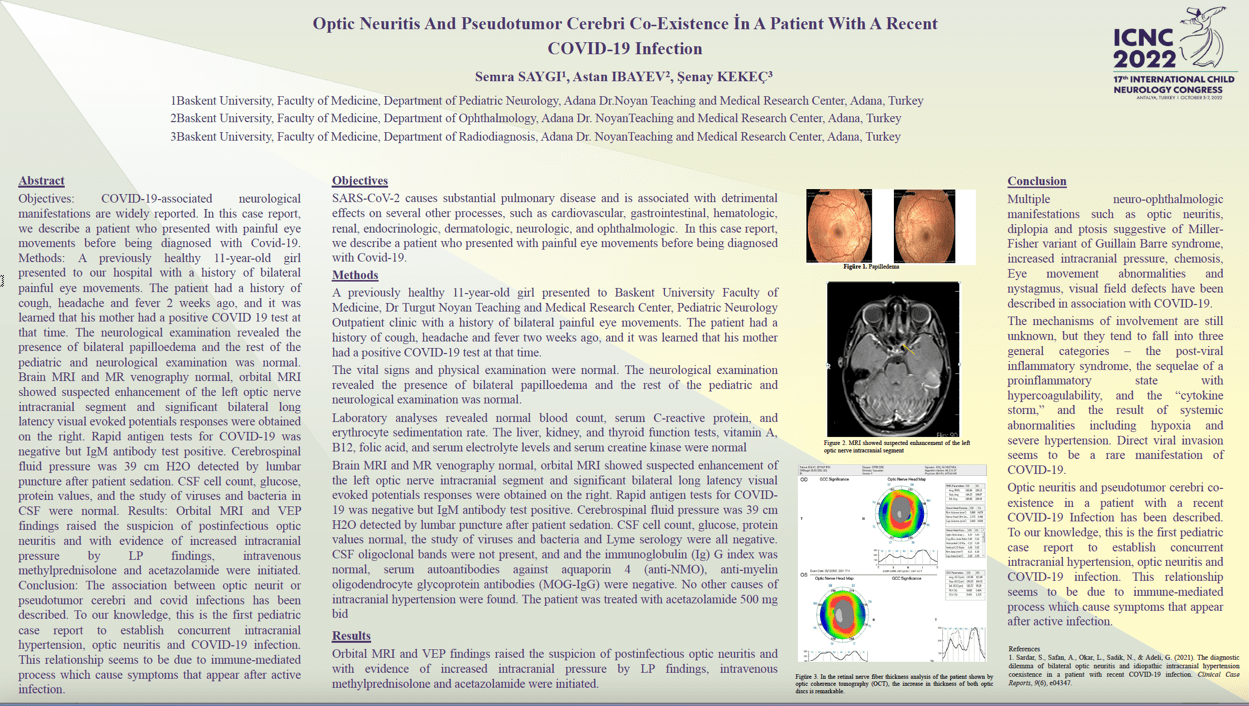Optic Neuritis And Pseudotumor Cerebri Co-Existence İn A Patient With A Recent COVID-19 Infection
SEMRA SAYGI, ŞENAY DEMİR, ASTAN IBAYEV
Objectives: COVID-19-associated neurological manifestations are widely reported. In this case report, we describe a patient who presented with painful eye movements before being diagnosed with Covid-19. Methods: A previously healthy 11-year-old girl presented to our hospital with a history of bilateral painful eye movements. The patient had a history of cough, headache and fever 2 weeks ago, and it was learned that his mother had a positive COVID 19 test at that time. The neurological examination revealed the presence of bilateral papilloedema and the rest of the pediatric and neurological examination was normal. Brain MRI and MR venography normal, orbital MRI showed suspected enhancement of the left optic nerve intracranial segment and significant bilateral long latency visual evoked potentials responses were obtained on the right. Rapid antigen tests for COVID-19 was negative but IgM antibody test positive. Cerebrospinal fluid pressure was 39 cm H2O detected by lumbar puncture after patient sedation. CSF cell count, glucose, protein values, and the study of viruses and bacteria in CSF were normal. Results: Orbital MRI and VEP findings raised the suspicion of postinfectious optic neuritis and with evidence of increased intracranial pressure by LP findings, intravenous methylprednisolone and acetazolamide were initiated. Conclusion: The association between optic neurit or pseudotumor cerebri and covid infections has been described. To our knowledge, this is the first pediatric case report to establish concurrent intracranial hypertension, optic neuritis and COVID-19 infection. This relationship seems to be due to immune-mediated process which cause symptoms that appear after active infection.
Keywords: Optic Neuritis, Pseudotumor Cerebri,COVID-19 Infection, Child
SEMRA SAYGI
Baskent University, Faculty of Medicine
Turkey
ŞENAY DEMİR
Baskent University, Faculty of Medicine
Turkey
ASTAN IBAYEV
Baskent University, Faculty of Medicine
Turkey
Objectives: COVID-19-associated neurological manifestations are widely reported. In this case report, we describe a patient who presented with painful eye movements before being diagnosed with Covid-19. Methods: A previously healthy 11-year-old girl presented to our hospital with a history of bilateral painful eye movements. The patient had a history of cough, headache and fever 2 weeks ago, and it was learned that his mother had a positive COVID 19 test at that time. The neurological examination revealed the presence of bilateral papilloedema and the rest of the pediatric and neurological examination was normal. Brain MRI and MR venography normal, orbital MRI showed suspected enhancement of the left optic nerve intracranial segment and significant bilateral long latency visual evoked potentials responses were obtained on the right. Rapid antigen tests for COVID-19 was negative but IgM antibody test positive. Cerebrospinal fluid pressure was 39 cm H2O detected by lumbar puncture after patient sedation. CSF cell count, glucose, protein values, and the study of viruses and bacteria in CSF were normal. Results: Orbital MRI and VEP findings raised the suspicion of postinfectious optic neuritis and with evidence of increased intracranial pressure by LP findings, intravenous methylprednisolone and acetazolamide were initiated. Conclusion: The association between optic neurit or pseudotumor cerebri and covid infections has been described. To our knowledge, this is the first pediatric case report to establish concurrent intracranial hypertension, optic neuritis and COVID-19 infection. This relationship seems to be due to immune-mediated process which cause symptoms that appear after active infection.
Keywords: Optic Neuritis, Pseudotumor Cerebri,COVID-19 Infection, Child
SEMRA SAYGI
Baskent University, Faculty of Medicine
Turkey
ŞENAY DEMİR
Baskent University, Faculty of Medicine
Turkey
ASTAN IBAYEV
Baskent University, Faculty of Medicine
Turkey

SEMRA SAYGI
Baskent University, Faculty of Medicine Turkey
Baskent University, Faculty of Medicine Turkey